 NATIVE COPPER
NATIVE COPPER
- Chemistry: Cu, Elemental Copper
- Class: Elements
- Group: Gold
- Uses: Minor ore of copper, ornamental stone
Specimens
PHYSICAL CHARACTERISTICS:
- Color is copper colored with weathered specimens tarnished green.
- Luster is metallic.
- Transparency is opaque.
- Crystal System is isometric; 4/m bar 3 2/m
- Crystal Habits include massive, wires and arborescent or branching forms as the most common, whole individual crystals are extremely rare but when present are usually cubes and octahedrons. Occasionally, massive forms will show some recognizable crystal faces on outer surfaces.
- Cleavage is absent.
- Fracture is jagged.
- Streak is reddish copper color.
- Hardness is 2.5-3
- Specific Gravity is 8.9+ (above average for metallic)
- Associated Minerals are silver, calcite, malachite and other secondary copper minerals.
- Other Characteristics: ductile, malleable and sectile, meaning it can be pounded into other shapes, stretched into a wire and cut into slices.
- Notable Occurrences include Michigan and Arizona, USA; Germany; Russia and Australia.
- Best Field Indicators are color, ductility and crystal habit.
 Amethyst Galleries' Mineral Gallery MINERALS |
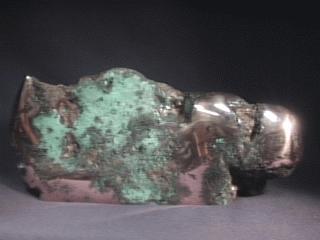
COPPER specimen cop-15
$ 250.00
$ 250.00
Dims: 11.5" x 5.4" x 1.8" (29.2 x 13.7 x 4.6 cm)
Wt: 15.4 lbs. (7.0 kg)
Keweenaw Peninsula, Michigan, U.S.A.
This large specimen consists of a section of "float" copper that made up part of an outcropping underground. It has a somewhat flat form and is partially covered in the bright green coating of oxidized copper. There are a few spots where some of the native igneous matrix rock is still attached, but these are minor. Portions of the specimen's surface have been ground smooth and polished to show the copper's reddish color and metallic luster. Most of the specimen is in its natural form, though. It has been almost completely coated with a lacquer to prevent further oxidation and decay of the copper. The only part of the specimen that I am certain is not covered with lacquer is the one cut surface that can be used as a rather sturdy "base" for its display. I have placed felt pads on this surface to prevent damage of any surface on which it is placed.

cop-15 ($250.00)
Keweenaw Peninsula, Michigan, U.S.A.

COPPER specimen cop-24
$ 400.00
$ 400.00
Dims: 14.1 x 10.5 x 1.5" (35.8 x 26.7 x 3.8 cm)
Wt: 25 lbs., 11 oz. (11.7 kg)
Keweenaw Peninsula, Michigan, U.S.A.
This impressive specimen consists of a large plate of native "float" Copper. It shows areas on one of its green, oxidized surfaces that have been ground smooth, polished, and then coated with a clear lacquer to prevent further oxidation. There also appear to be some very small areas that contain thin layers of noncrystalline cuprite, judging by their deep, almost rust-red color. The other side of the flat specimen is completey untouched, showing a heavily pitted surface that is stained green with oxidation. Such a piece would look magnificent on the mantle of a stone or slate fireplace!

cop-24 ($400.00)
Keweenaw Peninsula, Michigan, U.S.A.
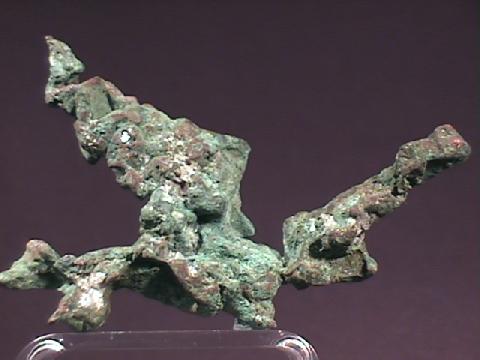
COPPER specimen cop-26
$ 55.00
$ 55.00
Dims: 3.1 x 2.2 x 0.6" (7.9 x 5.6 x 1.5 cm)
Wt: 2.9 oz. (81.6 g)
Michigan Mine, Ontonagon County, Michigan, U.S.A.
This oddly-shaped piece consists of a formation of heavily warped and intergrown Copper crystals. There is only a tiny amount of damage to the specimen, in the form of tiny spots of bright copper-red color and metallic luster on the green, dull surface. However, these spots may simply be points where the piece was attached to its place of origin, and represent separation points. The crystals that make up the specimen are so warped and intergrown that one cannot really define individual crystals, but faces and angles are present. There is a very small amount of white, formless calcite attached to the Copper, but no host or matrix rock.

cop-26 ($ 55.00)
Michigan Mine, Ontonagon County, Michigan, U.S.A.
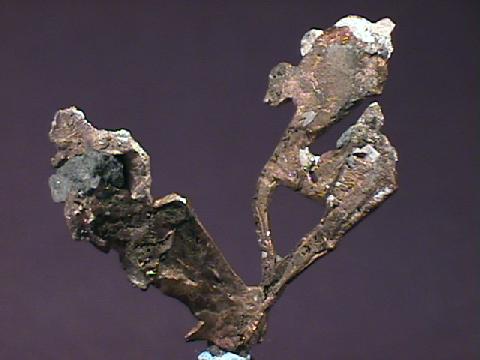
COPPER specimen cop-27
$ 80.00
$ 80.00
Dims: 1.9 x 1.3 x 0.3" (4.8 x 3.3 x 0.8 cm)
Wt: 6.6 g
White Pine Mine, Ontonagon County, Michigan, U.S.A.
This small specimen actually consists of both Native Copper and native silver, which sometimes associate with each other on pieces from this locality. The copper occurs both in a sheet form and as a thick, flattened wire which holds a small sheet to another sheet. The copper has a dull, coppery-red color and a dull metallic luster due to some slight oxidization, and appears to show some subtle signs of crystal form. The silver is attached to the ends of the copper sheets, and appears to continue on where the Copper left off in a similar form, but not showing as many crystalline tendencies. It has the standard bright, silvery color and a slightly higher luster in some areas. There are a few small bits of a black matrix rock stuck to the formation, one of which contains a tiny, transparent calcite crystal.
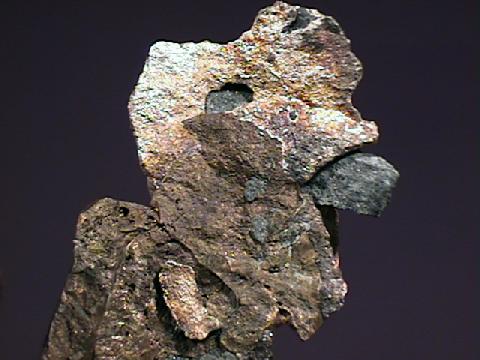

cop-27 ($ 80.00)
White Pine Mine, Ontonagon County, Michigan, U.S.A.
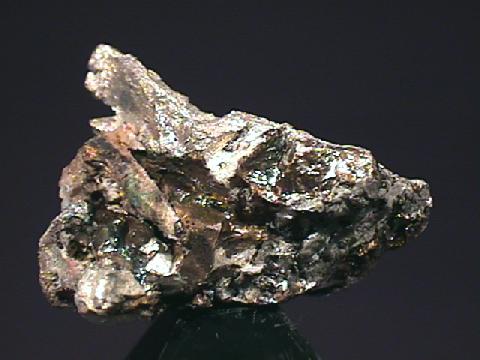
COPPER specimen cop-29
$ 75.00
$ 75.00
Dims: 1.0 x 0.8 x 0.7" (2.5 x 2.0 x 1.8 cm)
Wt: 16.4 g
Copper Falls, Keweenaw Peninsula, Michigan, U.S.A.
This small thumbnail specimen consists of intergrown formations of both native Copper and native silver. The Copper formation is mostly obscured by that of the silver, but is more crystalline and has a more interesting form. It has the standard copper-red coloration and a moderate metallic luster, and shows definite crystalline tendencies, and maybe even a few faces. While there is probably more silver than Copper on the piece, it has no discernable crystal form. Its color is the standard silvery-white and its metallic luster ranges from moderately dull to bright. There is no host rock present. Interestingly, there is some odd pale-yellow-to-pale orange discoloration with a slight greenish hint in a few areas where the two metals intersect. I am wondering if they may have possbily blended enough to form some sort of crude alloy?
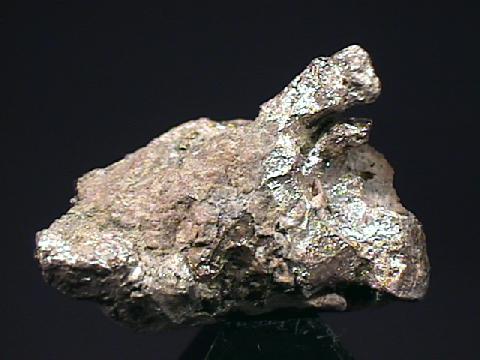

cop-29 ($ 75.00)
Copper Falls, Keweenaw Peninsula, Michigan, U.S.A.
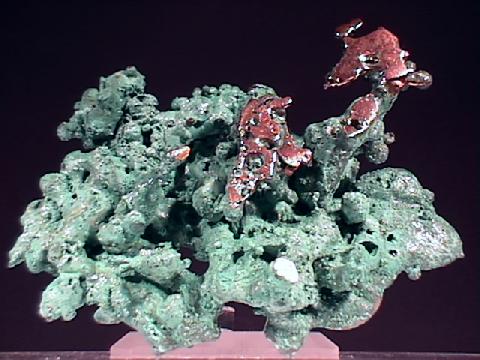
COPPER specimen cop-41
$ 32.00
$ 32.00
Dims: 4.5 x 3.5 x 1.1" (11.4 x 8.9 x 2.8 cm)
Wt: 11.4 oz. (322 g)
Michigan, U.S.A.
This copper specimen was likely given its form and coloration in a laboratory environment. It shows no evidence of crystal form or crystalline tendencies, and is very flat on one side of it, making me think that molten copper was dropped into a shallow basin of cooling solution. Furthermore, it appears to be coated with an oxidizing solution that gave the copper the bright green color that is normally associated with its oxidized state. A small amount opposite the flat surface of the piece has been ground away to expose fresh metal- it has the classic coppery-red coloration and metallic luster of the metal. The entire piece is coated with a thin layer of clear lacquer to prevent loss of the oxide coating and further oxidation .

cop-41 ($ 32.00)
Michigan, U.S.A.

COPPER specimen cop-42
$ 25.00
$ 25.00
Dims: 5.7 x 2.9 x 0.7" (14.5 x 7.4 x 1.8 cm)
Wt: 13.1 oz. (370 g)
Michigan, U.S.A.
This hand specimen consists of a chunk of amorphous raw copper. I do not call it "native copper", because even though it started out as such, it has been melted and then poured into a mold made out of wet straw. Thus, its form is not natural, nor is its green coating, which is made up of copper oxide mixed with a lacquer and other chemicals. The piece was completely covered with this coating and then partly ground to expose a few spots of fresh copper, which were then polished. Finally, it was completely coated with a clear lacquer to prevent further oxidation of the fresh copper surfaces.

cop-42 ($ 25.00)
Michigan, U.S.A.
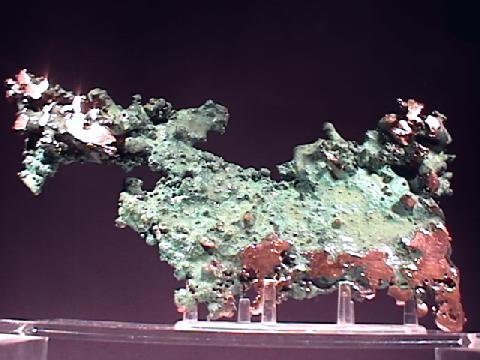
COPPER specimen cop-43
$ 58.00
$ 58.00
Dims: 10.0 x 5.5 x 1.0" (25.4 x 14.0 x 2.5 cm)
Wt: 1 lb., 8.5 oz. (695 g)
Michigan, U.S.A.
This specimen is not really "Native Copper". Likely it started out as bits and pieces of such, which were melted down and poured into a mold made out of wet straw, from which it got its shape. Most of it shows a green coloration, though there are portions that have been ground flat and polished to show the classic coppery-red color and metallic luster of this metal. However, there are also patches that have not been ground down which also show the metallic color and luster. This is because the piece has been "painted" with a mixture of powdered copper oxide suspended in a green paint to give it an "oxidized" appearance. It is a very flat piece that could be set upright on a small stand.

cop-43 ($ 58.00)
Michigan, U.S.A.
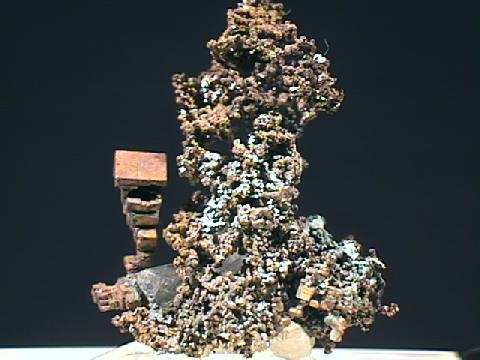
COPPER specimen cop-46
$ 156.00
$ 156.00
Dims: 0.9 x 0.7 x 0.4" (4.8 x 4.3 x 2.5 cm)
Wt: 9.2 g w/ acrylic base
White Pine Mine, Ontonogan County, Michigan, U.S.A.
Most of this small thumbnail specimen appears to consist of branching, arborescent Native Copper, but this material actually shows impressive crystal form when viewed under magnification, and even has crystalline tendencies to the naked eye. The formations are made up mostly of many tiny, intergrown cubes that show a rather dulled copper-red color and equally dull metallic luster. There is no apparent damage to the piece. One projection in particular is noticeable. This projection extends from the base of the piece upwards and parallel to the main formation. It consists of many intergrown Copper cubes that appear to be stacked on one another- all are directionally aligned, and the cubes increase in size from the bottom to the top of the formation. A small amount of colorless, crystalline calcite is intergrown near the base of the specimen, but there is no host rock present. It is hot-glued to a flat acrylic base which is affixed inside a plastic specimen box with a removable putty.
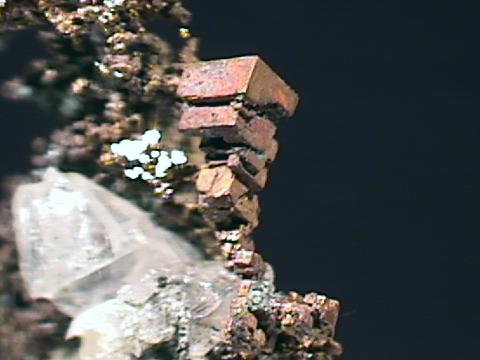

cop-46 ($156.00)
White Pine Mine, Ontonogan County, Michigan, U.S.A.
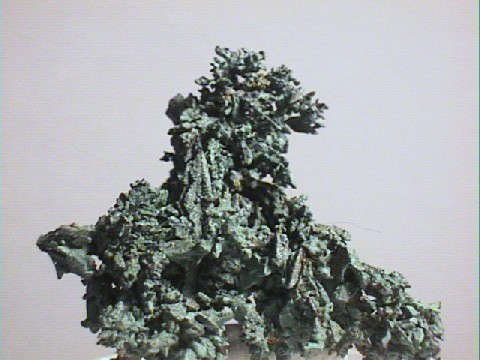
COPPER specimen cop-54
$ 45.00
$ 45.00
Dims: 1.7 x 1.4 x 0.7" (4,2 x 3.6 x 1.8 cm)
Wt: 0.5 oz. (13 g)
Ray Mine, Pinal County, Arizona, U.S.A.
This hand specimen consists of an arborescent native Copper formation. It is in good condition, showing subtle damage if any, and contains warped Copper crystals that do not exceed 0.2-0.3" (5-8 mm) in length. Even though they are warped, one can see evidence of Spinel-law twinning in some spots. Each surface has a dull, pale green oxide coating surrounding it. There is no base or host rock present.

cop-54 ($ 45.00)
Ray Mine, Pinal County, Arizona, U.S.A.
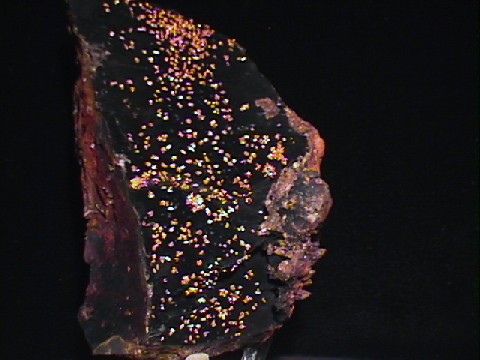
$ 200.00
Dims: 4.7 x 2.9 x 2.0" (11.9 x 7.3 x 5.0 cm)
Wt: 13.7 oz. (387 g)
Mexico
This cabinet specmien consists of a rusty limestone base on which rest scores of tiny native Copper crystals. These crystals do not exceed 1 or 2 mm in diameter and are generally in excellent condition, showing almost no damage. When viewed with a loupe, one can see reasonably good tetragonal and octahedral forms, along with some intergrowth and even some possible twinning. All have the standard bright coppery red color and metallic luster. They rest on a black oxide coating that partly covers the base. Oddly enough, there are not even visible traces of any secondary copper minerals on the piece.
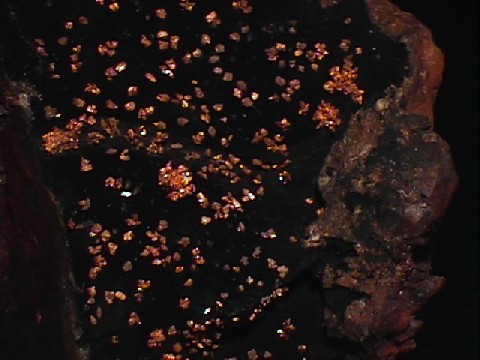

Mexico
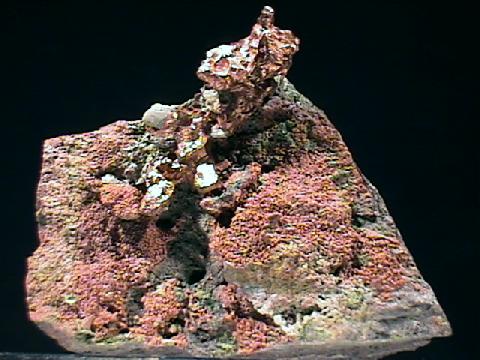
COPPER specimen cop-55
$ 25.00
$ 25.00
Dims:3.5x2.9x1.8" (8.9x7.1x4.6 cm)
Wt: 13.5 oz. (384 g)
Keweenaw Peninsula, Michigan, U.S.A.
Only a small amount of crysalline Native Copper is present on this hand specimen. It shows no definite damage and actually possesses a few discernable crystal faces. The Copper has the classic coppery-red coloration and metallic luster and interacts with a few small calcite crystals that it partially enveloped. It rests upon a thick slab of basalt that is also partly covered with a rust-colored druse of tiny ferroandolomite crystals.

cop-55 ($ 25.00)
Keweenaw Peninsula, Michigan, U.S.A.
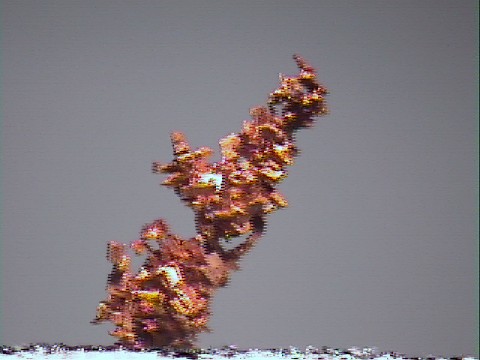
COPPER specimen cop-56
$ 72.00
$ 72.00
Dims: 1.0 x 0.6 x 0.3" (2.6 x 1.4 x 0.8 cm)
Wt: 2.2 g w/styrofoam base
White Pine Mine, Ontonogan County, Michigan, U.S.A.
This is another exceptional specimen from the White Pine Mine that shows genuine cubic copper crystals (instead of just pseudo-crystalline aborescent form). At first glance this thumbnail specimen appears to consist of branching, arborescent Native Copper, but close examination (especially under a loupe) shows impressive crystal form. The formations are made up mostly of hundreds of tiny, intergrown flattened cubes that show a rather dulled copper-red color and equally dull metallic luster. At least one elongated cube is clearly visible to the naked eye, having dimensions of over 2 mm on the square faces. There is no apparent damage to the piece.
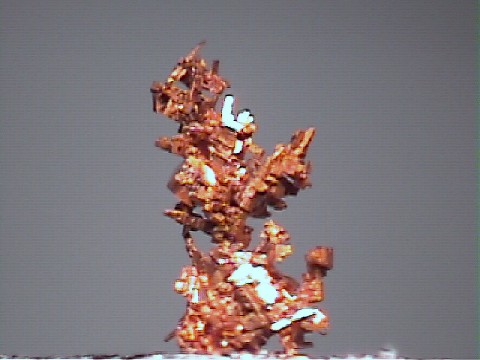

cop-56 ($ 72.00)
White Pine Mine, Ontonogan County, Michigan, U.S.A.
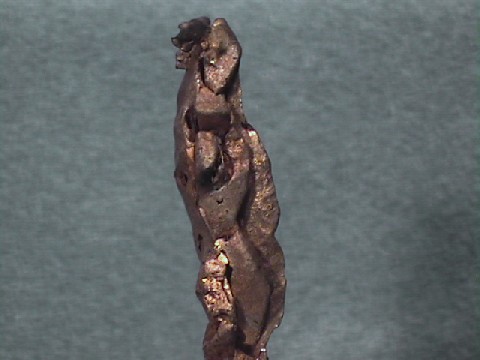
COPPER specimen cop-57
$ 30.00
$ 30.00
Dims: 1.26x0.31x0.28" (3.2x0.8x0.7cm)
Wt: 0.12 oz. (3.5g)
Ray, Arizona, USA
Hey, twin fans, this is a spinel twin crystal of copper. It is not perfect, but it is unmistakable. The copper is clean and shows no sign of tarnish.

cop-57 ($ 30.00)
Ray, Arizona, USA
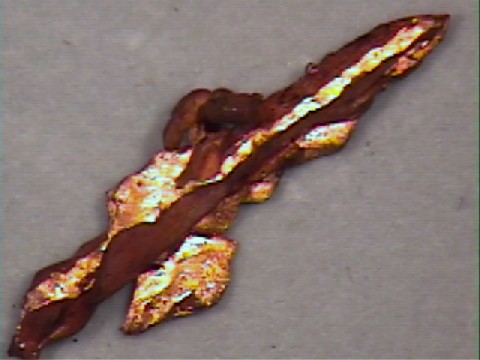
COPPER specimen cop-58
$ 30.00
$ 30.00
Dims: 1.27x0.48x0.31" (3.23x1.23x0.78cm)
Wt: 11.2 ct (2.24g)
Ray, Arizona, USA
This is a single crystal spinel twin of copper. Its color is copper, naturally, and it has an interesting luster I'll call "soft metallic" due to a fine surface texture. While not a perfectly shaped spinel twin, it does have multiple blades and an unmistakable crystal form.

cop-58 ($ 30.00)
Ray, Arizona, USA
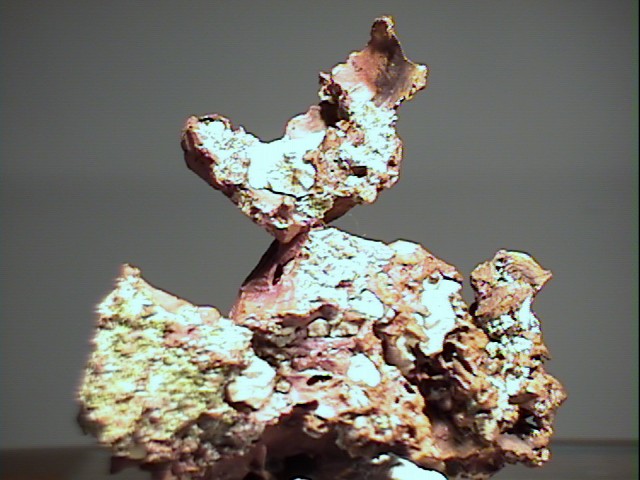
COPPER specimen cop-59
$ 47.00
$ 47.00
Dims: 1.73x1.59x0.67" (4.40x4.03x1.70cm)
Wt: 0.88oz (24.8g)
Fagottiville, Michigan, USA
This is a somewhat oddly shaped specimen of natural copper form the upper peninsula of Michigan. It looks like a dish antennae perched on a rock. It is accompanied by several other minerals, largely the white limestone host rock that has been largely etched away to reveal the copper, plus an unidentified sparkly green mineral (I thought it was green corrosion until I examined it with a loupe - it is clear, transparent, green, and vitreous, but I cannot identify it), plus some blue that looks like chrysocola. The specimen has many sharp edges and crystalline indications, although I suspect that these are imprint faces from the host calcite.

cop-59 ($ 47.00)
Fagottiville, Michigan, USA
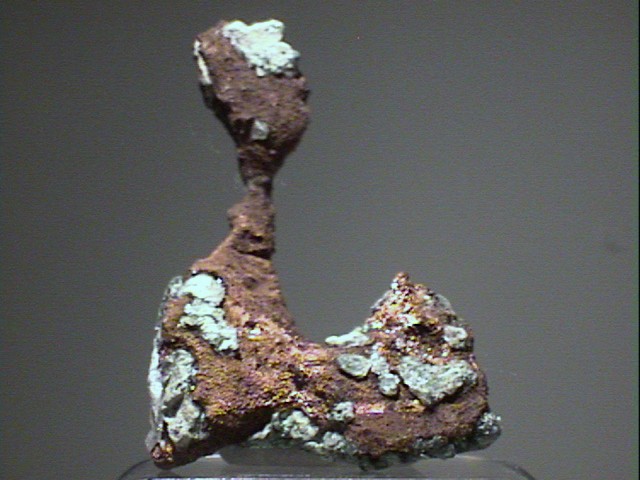
COPPER specimen cop-60
$ 35.00
$ 35.00
Dims: 2.22x1.49x0.89" (5.63x3.79x2.27cm)
Wt: 2.51oz (70.9g)
Osceola Mine, Fagottiville, Michigan, USA
This is a native copper specimen from the Upper Pennisula of Michigan. It is primarily copper, with about 20% of its surface covered by the remaining host rock, an impure limestone. The copper shows no indications of crystal form. The surface texture is unusual, in that it is very rough and pitted on a fine scale, yet there is a suprising amount of luster. Indeed, much of the surface is irridescent in hues of gold, orange, and red.

cop-60 ($ 35.00)
Osceola Mine, Fagottiville, Michigan, USA
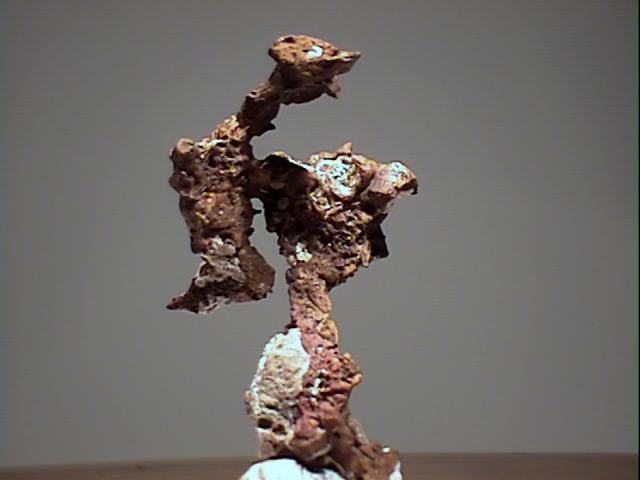
COPPER specimen cop-61
$ 30.00
$ 30.00
Dims: 1.89x1.08x0.89" (4.80x2.75x2.27cm)
Wt: 0.59oz (16.7g)
Fagottiville, Michigan, USA
While mostly dull with an almost velvet luster, this copper specimen does have several areas that look like crystal faces, although these may simply be imprints of host calcite crystals that have since been etched away. Except for those crystalline areas, the color is a brownish-copper, with tints of red in some areas, and a more pure copper appearance in others. A loupe reveals that the surface is covered with fine pits and an irridescent red tarnish which yields (at different angles) both the velvet copper and the dull brownish-copper appearance.
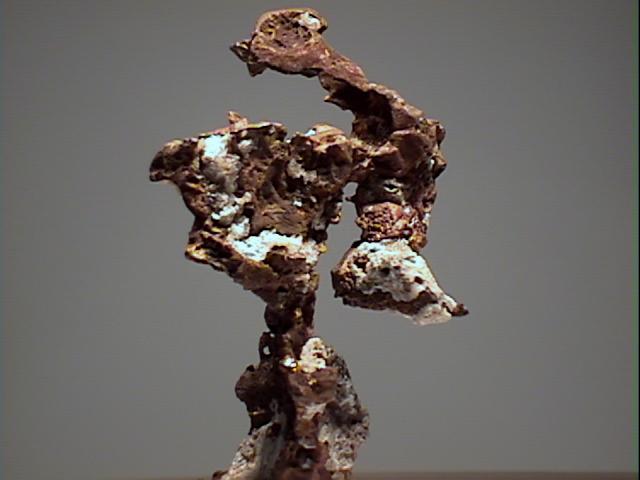

cop-61 ($ 30.00)
Fagottiville, Michigan, USA
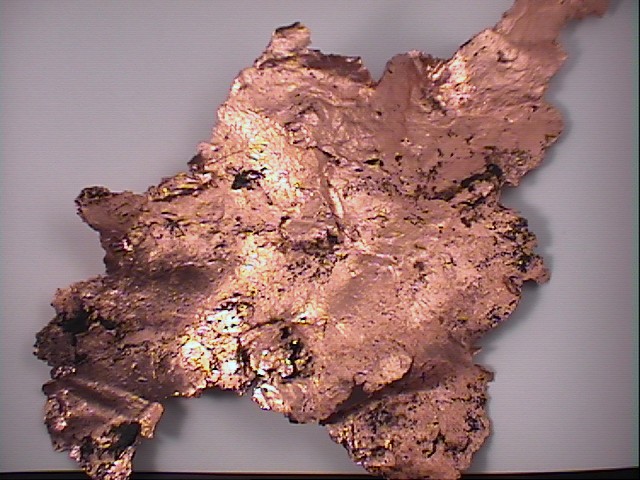
COPPER specimen cop-62
$ 60.00
$ 60.00
Dims: 13.93x8.07x1.52" (35.38x20.51x3.86cm)
Wt: 12.06oz (342g)
Keweenaw Peninsula, Michigan, USA
This is an example of native copper that crystallized between layers of slate. While there are a few small areas which have a crystalline appearance, for the most part, the copper simply filled all available crevices in the host slate. Some bits of the black slate are still attached, especially where it fills sections between copper sheets and thus could not be removed. The copper itself is relatively thin, the thickest part measures 11.36mm - this is clearly a sheet of copper. Note that there are several areas where parallel copper sheets are attached and can flex. One of these is surprisingly loose. The copper has a perfect copper color, with a metallic luster, and while the surface texture is rather smooth in most places, there are areas with a granular texture.
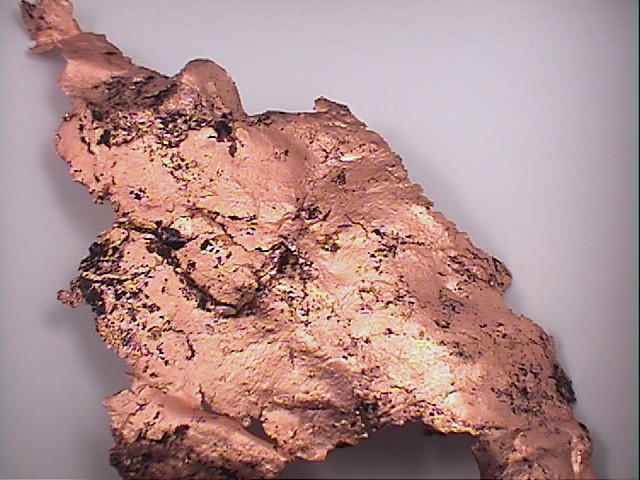

cop-62 ($ 60.00)
Keweenaw Peninsula, Michigan, USA

COPPER specimen cop-63
$ 95.00
$ 95.00
Dims: 9.70x5.64x1.40in (24.65x14.31x3.55cm)
Wt: 43.03oz (1220g)
Keweenaw, Michigan, USA
While not a natural mineral specimen, this is still an interesting piece of mineral art. It was made by pouring molten natural copper (melted, not refined, native copper mined in Keweenaw) into a pile of wet straw, then pouring acid to give exposed copper a green tarnish, then finally polishing some surfaces to expose the copper within.


cop-63 ($ 95.00)
Keweenaw, Michigan, USA

COPPER specimen cop-64
$ 120.00
$ 120.00
dims mm=650x340x10
wt g=1791
Keweenaw Peninsula, Michigan, USA
This large sheet of natural copper from Michigan's Upper Pennensula would make an interesting decorator piece, possibly hung on a wall like a picture. It has the expected copper color, with a rather dull surface due to thousands of tiny pits.


cop-64 ($120.00)
Keweenaw Peninsula, Michigan, USA